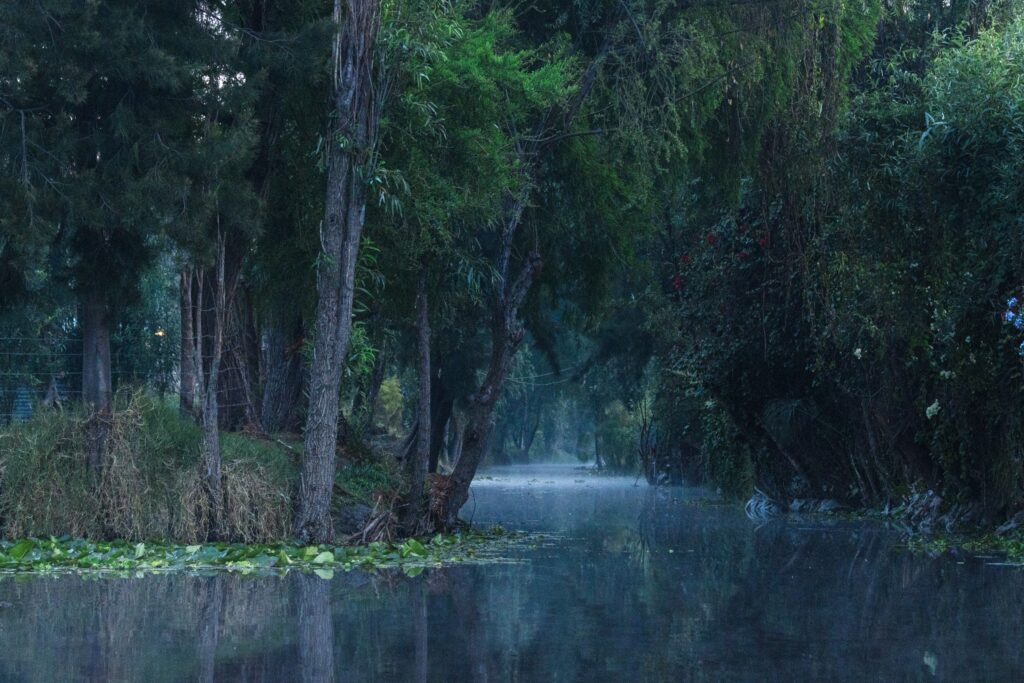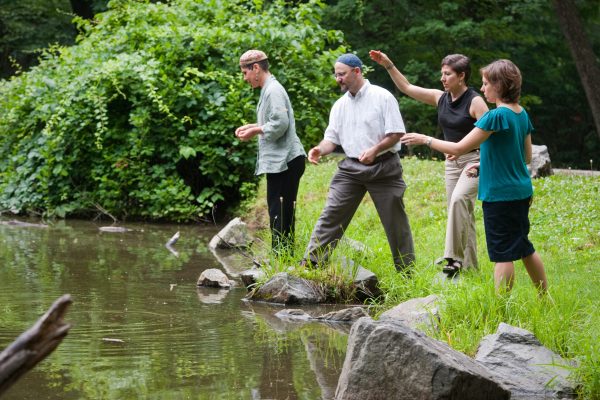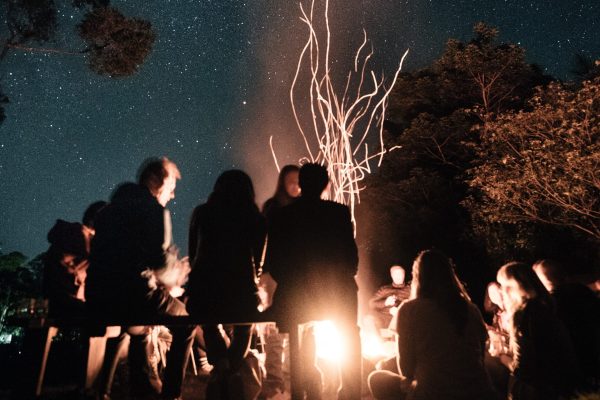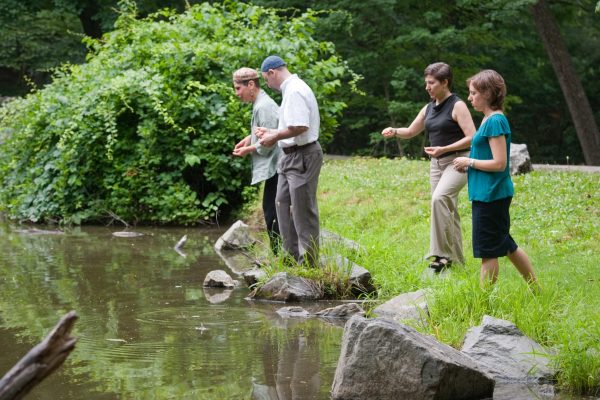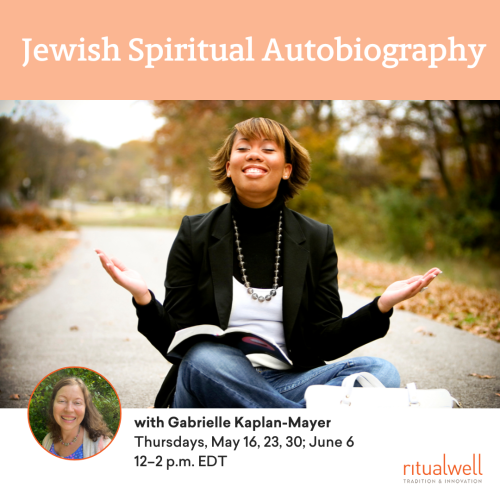There we stood, at the banks of the river in the dark of the night under the full moon, an outer circle of women and an inner circle of young girls, celebrating the entrance of my daughter into womanhood. How we got there is a tale, not of geography but of inner space.
Changes in consciousness… not a plunge from a precipice, but small steps, one at a time, seeds that look as if they’ve been scattered to the winds but somehow take root.
I first heard about the notion of a menarche ceremony in 1979, from Mary and Everett Gendler, at the first HavurahLit. Group of friends Commonly has come to mean an alternative prayer community. In the 1970’s, havurot (plural) developed as an alternative to large syngagogues. Some havurot pray together; others study, socialize, or engage in some alternative activity. Conference. The idea excited me but also made me feel vaguely uncomfortable. The unconscious process had begun.
During the years that followed, the dormant seeds received nourishment from the way I was feeling about my own body and celebrating it. About a year ago, my women’s group, at one of our weekly meetings, talked about the books that had informed us as women and feminists. Another piece.
And then, at the East Coast Jewish Women’s Conference in October 1983, I attended a session run by several members of the Philadelphia Jewish Feminist Liturgy Group. They posed a question that stirred my imagination: If we women frequently feel ourselves outside of the tradition, if we often struggle to find meaning in ceremonies that are male-oriented or irrelevant to our modern lives, what moments of life that are significant to us have cried out for community acknowledgment, support, celebration?
My answer was clear. The vague seeds of five years before had, by then, taken firm root. Though many other life moments came to my mind, the one that called loudest, with thoughts of my rapidly maturing 12-year-old daughter in the background, was the onset of menstruation. I began to talk about the idea – with her, with friends, both female and male — and though I knew there were already some ceremonies that had been devised and enacted, I didn’t want to hear about them. My own images were coming fast— full moon, water, books. Ideas were beginning to flower, but when would this life-changing moment come about? I feared it would happen deep in the winter or when Morissa was away at camp.
In early May 1984, barely two weeks before Morissa’s thirteenth birthday and four weeks before her Bat MitzvahLit. Commandment. It is traditionally held that there are 613 mitzvot (plural) in Judaism, both postive commandments (mandating actions) and negative commandments (prohibiting actions). Mitzvah has also become colloquially assumed to mean the idea of a “good deed.", at the time of Rosh HodeshThe new moon, which marks the beginning of the Jewish month. According to tradition, because women did not participate in the sin of the golden calf, they were given the holiday of Rosh Chodesh. It is customary for women not to work on Rosh Chodesh. Iyyar, while she and I were working on her Bat Mitzvah parasha, the moment of change came. It was a quiet moment between the two of us, not at all embarrassing or shameful (as I remember my own entrance into womanhood). We talked about whom we would tell—which relatives, which friends—and who would tell the men in our lives — her dad, grandpa, brother, my partner.
This was the moment I had been waiting to celebrate with her, but all my creative energies were wrapped up in Morissa’s Bat Mitzvah. Could I stretch myself for the ceremony now, or would it have to wait another month? The answer was clear, even compelling. When, on the new moon, in the very month of calendric adolescence and spiritual adulthood, my daughter also reached biological womanhood, it felt like a blessing from the universe. We all pray to be integrated, whole; here, in her thirteenth year, body, spirit, and age had come together to proclaim “woman.” How could we mortals do less than sing praises to the Source of this miracle?
So invitations hastily went out: dear friends, women from my women’s group, Havurat Rey-im of Teaneck, B’nai Or of New York, my educational-professional Counseling-Learning network, and others who have been long and deep parts of our lives. We invited women to bring their young daughters — those who were not yet biologically women — in the hope that this ceremony might make the onset of womanhood easier for them. I asked women to join us at 9:15 p.m. on the night of the full moon, on the New Jersey banks of the Hudson River. I asked them to bring for Morissa some “woman-Torah”: a poem or essay or book that had been significant in their learning about themselves as women.
Responses to our invitation were mixed. From some people there were joyous hallelu-yahs: About time for what’s significant in a woman’ life to be celebrated! From others, more dubious responses: In a book, it sounds exciting, but in real life? What kind of ceremony is this going to be—rooted in Judaism or witchcraft? Maybe, said some, we should be proud of the first menstruation, but doesn’t it really call for a private and personal celebration? I don’t know about your daughter, said some, but I — or my daughter — wouldn’t want such a ceremony.
These messages/doubts penetrated me-hints of a discarded voice of fear and convention – and finally I turned in question to Morissa. Your“aliya” to the TorahThe Five Books of Moses, and the foundation of all of Jewish life and lore. The Torah is considered the heart and soul of the Jewish people, and study of the Torah is a high mitzvah. The Torah itself a scroll that is hand lettered on parchment, elaborately dressed and decorated, and stored in a decorative ark. It is chanted aloud on Mondays, Thursdays, and Shabbat, according to a yearly cycle. Sometimes "Torah" is used as a colloquial term for Jewish learning and narrative in general., your period, your thirteenth birthday, I told her, are all merely symbols. They are not what being a woman is about. To me, the bridge from childhood to womanhood is about decision-making and commitment.
It’s so much easier, when people ask where you stand, to retreat behind ambivalence, uncertainty, to make no decisions or to keep changing your mind. It’s so hard — when you know that some people want you to do this or think that — to take an opposing position, and then stick with it when the going gets tough. Many people wear the outer symbols that mark the change of age, but few indeed learn that coming of age is about checking out who you are at a given moment and taking responsibility for that person.
So, I told Morissa, there are no wrong answers to the question I’m about to ask. It requires only that you look into yourself and answer from your own truth: do you or do you not want a woman-ceremony? Whatever your answer, I assured her, it is the process of making a decision and standing firm with it that is the real celebration of maturity.
Morissa answered firmly that she intended to have the ceremony.
The night arrived — not exactly as imagined but powerful nonetheless. Rain clouds and thick trees hid the full moon. The early closing of the Palisades Interstate Park moved us from the flowing Hudson to a trickling brook. The arrival of police cars — keeping the neighborhood safe — gave the most natural of ceremonies a hint of the forbidden and eerie.
More than a dozen of us, holding candles to share with the moon the task of illuminating the dark, gathered in a circle with Morissa and the other young girls in the center. We sang the song “Love is the only answer” from a David Zeller album, which ends with the words “watch our circle grow.”
As I gazed at the faces of loved friends in the circle, I realized that a world of possibilities of living as a woman were represented in that circle: married women with children; unmarried women with children; married women without children; unmarried women with lovers either male or female; unmarried women without lovers. The straight-and-narrow slice of the world which was offered to me as truth-and-all when I began to menstruate, has, like the full moon, swelled with possibilities for Morissa and the young women of her generation. But do we dare show it to our children?
I began the ceremony by supplying some background.
We bring the ordinary into holy consciousness through ceremony/service/celebration. By moving a life-moment from its private enclosure, often clouded with secrecy, fear, shame, and curse, we confront those feelings that have lived for generations within us, and replace them with pride in the miraculous workings of our body.
For many of us who have grown up with ambivalent messages from our mothers and grandmothers, this affirming message does not come so easily to pass on to our daughters. We don’t really know where or why we hide this life passage —which many cultures don’t hide— but we have internalized the need for secrecy.
We have finally come of age as women to ask: what have we lost in our failure to take pride in our changing bodies? What does that say about our feelings for ourselves, our daughters, our community of sisters? It is time to use ceremony to purge us from feelings of shame, disconnectedness, ordinariness.
This ceremony of menstruation calls for a moonlit night: the moon, like a woman’s cycle, waxing and waning; the full moon like an egg bursting forth from the ovary fully ripe. The full moon, coming right in the middle of Morissa’s cycle, gives a feeling of congruence, of being on target, of being in touch with the Holy One of Being. How absolutely right it feels tonight to celebrate Morissa’s fullness with that of the moon and our “weave of women” (as EstherHeroine of the Purim story and Megillat (the scroll of) Esther. She is married to the king by her cousin Mordecai and ultimately saves her people from execution. Broner’s novel has named it)!: the very ceremony is a microcosm of what it means to be a woman, to speak a special intuitive language with other women and the universe.
As Jews, we symbolically give our children the Torah as their inheritance/path of life upon their Bat/Bar Mitzvah. So, for menarche, I called upon the women in the circle to hand down to Morissa a teaching that had come from their own or other people’s woman-experience.
Some spoke of Morissa from themselves; others read from books or poems or stories. People spoke about friendship; about pregnancy and childbirth; about belonging to community; about learning that women friends were not to be discarded when men came into their lives. I said —with some trepidation — that while she was still too young for my message, I welcomed her to a time when her mind and heart would catch up with her body, and she would be able to experience—as I have — the sheer pleasure of living in a woman’s body.
Friends gave Morissa all kinds of books, as widely divergent at the lifestyles of the women present: A Gift from the Sea by Anne Morrow Lindberg; an anthology of women poets:Dreaming the Dark by Starhawk; The Little Prince by Antoine de Saint-Exupery; The Moon is Always Female by Marge Piercy; a book of short stories to remind Morissa that reading makes for companions of infinite imagination; The Women’s Room by Marilyn French; Our Bodies, Ourselves by the Boston Women’s Health Collective; some specific poems; A Child is Born, the photographic collection by Linnart Nielson of embryo/fetus developing throughout pregnancy into childbirth; and several blank books waiting to be written by Morissa herself. Though many of the books are beyond Morissa’s understanding or interest right then, they stood on her shelves as a legacy to explore when she would be ready, like treasure chests in the attic.
So, too, many of the words said or read to her were more than she could fully take in that night, but Morissa did know that she had received a welcoming full of love and hope.
From our Native American sisters we had learned of a menarche ceremony – including men as well as women – in which the community sits in watch through the night over the rising corn bread. The night before Morissa’s ceremony, she and I sate up through most of the night, kneading, talking, and watching the rising tashlih challahBraided egg bread eaten on Shabbat and holidays. Reminiscent of bread eaten by Priests in the Temple, of manna in the desert, and sustenance in general. Plural: Hallot. It was her first time to take charge (not merely to assist me) in the baking of challah. We brought her baked loaves to her ceremony, invited women to savor the taste but to save a small piece for the “tashlih” to follow.
Along with the moon as symbol, the ceremony called for water: water reminding us of the birth waters which bring forth new selves; and of MiryamMiriam is the sister of Moses and Aaron. As Moses' and Aaron's sister she, according to midrash, prophesies Moses' role and helps secure it by watching over the young baby, seeing to it that Pharaoh's daughter takes him and that the baby is returned to his mother for nursing. During the Israelites' trek through the desert, a magical well given on her behalf travels with the Israelites, providing water, healing, and sustenance., who sweetened the water in the desert so that it was fit to drink. Had the night been warmer – another month into summer’s heat – I would have chosen a site where we could have used water for a mikvaThe ritual bath. The waters of the mikveh symbolically purify – they are seen as waters of rebirth. A convert immerses in the mikveh as part of conversion. Many Orthodox married women go to the mikveh following their period and before resuming sexual relations. Couples go to the mikveh before being married. Many, including some men, immerse before Yom Kippur; some go every Friday before Shabbat. (ritual bath) – not from the tradition that calls for cleansing what is impure, but rather from the place of purifying our consciousness.
We often take for granted that extraordinary blessing which is our naturally functioning bodies. By immersing ourselves fully into cold water, we are startled to awareness that which is with us all the time is itself a miracle. By purifying our vision, we can see the (w)holiness that is all-present. In lieu of mikva on this cool May night, we used our crumbs of challah for a tashlih ceremony.
TashlichCasting bread upon the water. On Rosh Hashana, Jews traditionally walk to a natural body of water into which they throw breadcrumbs, symbolic of their sins from the previous year. (traditionally done by casting crumbs upon a body of running water on the second day of Rosh HashanahThe Jewish New Year, also considered the Day of Judgment. The period of the High Holidays is a time of introspection and atonement. The holiday is celebrated with the sounding of the shofar, lengthy prayers in synagogue, the eating of apples and honey, and round challah for a sweet and whole year. Tashlikh, casting bread on the water to symbolize the washing away of sins, also takes place on Rosh Hashana. as part of the Ten Days of in-looking) does not have to be understood as simply casting off those deadly parts of ourselves we want to be rid of, but rather as a turning around to see a life-giving aspect of the same parts. At this moment marking the transition between childhood and adulthood, I invited everyone in the circle to look into themselves at those aspects that were still childish and immature. Once we were able to identify those parts of ourselves, we might symbolically cast them upon the crumbs of challah into the brook so that the waters might turn them around and allow us to retain our wonder-full childlikeness in a more disciplined, mature fashion.
As we searched within ourselves and lined the banks of the brook, turning the child in ourselves from an out-of-control state into a find-tuned one, we sang the song “Return Again” (from Shlomo Carlebach via David Zeller’s album), which ends with the words “: Return to where you are born and reborn again.”
We regathered into our inner and outer circles, making a “bracha” over wine. That blessing, as the one for challah, was recited in “traditional” as well as “feminized” Hebrew and translated into “midrashic” English.
בְּרוּכָה אַתְּ הַשְּׁכִינָה מְקוֹרֶת הַחַיִּים בּוֹרֵאת פְּרִי הֲגַפֶן
B’ruha At Shehina, Makor haHayim, boreyt p’ri Hagafen.
“Blessed are You, ShechinaThe feminine name of God, expounded upon in the rabbinic era and then by the Kabbalists in extensive literature on the feminine attributes of the divine., Source/Sorceress of all life, Who has made the fruits of the vine sweet to our taste, in the familiar color of our life-giving blood.”
Then, in the fullness of the night, we recited two blessings that are normally part of the morning service:
בָּרוּךְ אַתָּה אֲדֹנָי אֱלֹהֵינוּ מֶלֶךְ הָעוֹלָם שֶׁעָשָׂנִי בְּצֶלֶם אֱלֹהִים
Baruh Ata YHWH, eloheynu ru-ah ha-dam shehasani b’tzelem Elohim.
Blessed are You, Holy One of Being, Mother-and-Father of us all, Who has made me in Your image, like AdamAdam is the first human being created by God. Symbolizes: Creation, humankind. from the Adamah upon creation, with the feminine and masculine sides still intertwined.
בָּרוּךְ אַתָּה אֲדֹנָי אֱלֹהֵינוּ מֶלֶךְ הָעוֹלָם שֶׁעָשָׂנִי אִשָּׁהּ
Bruha At ShekhinahThe feminine name of God, expounded upon in the rabbinic era and then by the Kabbalists in extensive literature on the feminine attributes of the divine. she-astani isha.
Blessed are You, Holy one of Being, Mother-and-Father of us all, Who has created me predominantly and joyously female.
And then, as we invited Morissa to move from the inner circle where she stood with four other young girls, into our outer circle of women, we sang:
בְּרוּכָה אַתְּ יָהּ אֱלֹהֵינוּ רוּחַ הָעוֹלָם שֶׁהֶחֱיָתְנוּ וְקִיְּמָתְנוּ וְהִגִּיעָתְנוּ לַזְּמָן הַזֶּה
Brukha At YHWH eloheynu ru-akh ha olam shekheyatnu, v’Kiy’matnu v’hig-atnu lazman hazeh.
Blessed are You, Holy One of Being, Parent of us all, Who has brought us with great joy to this moment of change in Morissa’s life and in the lives of all of us joined in celebration.
In closing we sang again the Zeller melody “Watch our Circle Grow.”
As we come to love ourselves, including the wondrous workings of our bodies, the love flows naturally to our daughters and sons, our friends and lovers, our mothers and fathers, our community, and those whom we still consider strangers.
כֵּן יְהִי רָצוֹן
Kayn y’hi ratzon! – May it be so!
Excerpted from A TIME FOR EVERY PURPOSE UNDER HEAVEN by Arthur Ocean Waskow and Phyllis Ocean Berman. Published by Farrar, Straus & Giroux. Copyright 2002 by Arthur Ocean Waskow and Phyllis Ocean Berman. All rights reserved

